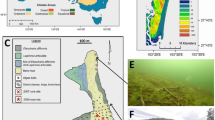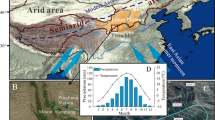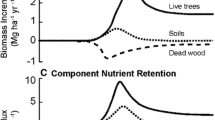Abstract
Opal, organic C and N contents, and organic δ13C and δ15N stable isotopes were analyzed on a sedimentary sequence spanning the past ~12,000 years from Dune Lake, a shallow groundwater-fed lake in the boreal forest region of central interior Alaska. The chronology, based on 210Pb and 15 AMS radiocarbon dates on terrestrial materials, indicates that 5 m of biogenic sediment accumulated following dune stabilization at ~10,000 cal yr BP. Previous studies on lake level and pollen were synthesized with these data to assess Holocene changes in hydrogeology and climate. Variability in groundwater level and flux has a strong control on lake level and are negatively correlated with the δ13C of organic matter produced within the lake. This relationship results from the input of groundwater with high pCO2 and with dissolved inorganic carbon depleted in 13C, which subsequently affects lake phytoplankton δ13C signatures. A rapid rise in lake level between ca. 11,000 and 9,500 cal yr BP coincided with stabilization of the dune field adjacent to the lake and expansion of vegetation around the lake, including white spruce. Organic δ13C values are relatively low and constant between about 10,000 and 6,000 cal yr BP, and then steadily increase until about 2,000 cal yr BP, suggesting a pattern of high followed by dropping lake levels generally consistent with results from core-transect studies. Higher-frequency fluctuations of 2–3 ‰ in δ13C are common, and suggest variability in aspects of the lake-carbon cycle over multi-decadal timescales. Recent trends in groundwater and lake level, river discharge, and precipitation suggest an important role for wintertime precipitation in the regional groundwater system. The unusual hydrology of this system relative to most other lakes studied for paleoclimate in this region provides a novel insight into different seasonal aspects of Alaskan paleoclimatology. The record is consistent with a general long-term decrease in wintertime precipitation, possibly accompanied by an increase in permafrost extent, over the Holocene.






Similar content being viewed by others
References
Abbott MB, Finney BP, Edwards ME, Kelts KR (2000) Lake-level reconstructions and paleohydrology of Birch Lake, central Alaska, based on seismic reflection profiles and core transects. Quat Res 53:154–166
Alexander V, Barsdate RJ (1974) Limnological studies of a subarctic lake system. Int Rev Gesamten Hydrobiol Hydrogr 59:737–753
Anderson L, Abbott MB, Finney BP (2001) Holocene paleoclimate from oxygen isotope ratios in lake sediments, central Brooks Range, Alaska. Quat Res 55:313–321
Anderson L, Abbott MB, Finney BP, Edwards ME (2005) Paleohydrology of the southwest Yukon Territory, Canada, based on multi-proxy analyses of lake sediment cores from a depth transect. The Holocene 15:1–12
Barber VA (2002) Millennial to annual scale paleoclimatic change in central Alaska during the late Quaternary interpreted from lake sediments and tree rings. Ph.D. thesis, University of Alaska, Faibanks
Barber VA, Finney BP (2000) Late Quaternary paleoclimatic reconstructions for interior Alaska based on paleolake-level data and hydrologic models. J Paleolimnol 24:29–41
Barber VA, Juday GP, Finney BP (2000) Reduced growth in Alaskan white spruce from 20th century temperature-induced drought stress. Nature 405:668–673
Bartlein PJ, Anderson KH, Anderson PM, Edwards ME, Mock CJ, Thompson RS, Webb RS, Whitlock C (1998) Paleoclimate simulations for North America over the past 21,000 years: features of the simulated climate and comparisons with paleoenvironmental data. Quat Sci Rev 17(6–7):549–585
Bigelow N (1997) Late Quaternary vegetation and lake level changes in central Alaska. Ph.D. thesis, University of Alaska, Fairbanks
Carlson LJ, Finney BP (2004) A 13,000 year history of vegetation and environmental change at Jan Lake, east-central Alaska. The Holocene 14:818–827
Chapin FS III, McGuire D, Ruess R, Walker M, Boone R, Edwards ME, Finney BP, Hinzman L, Jones J, Juday G, Kasischke E, Kielland K, Lloyd A, Oswood M, Ping C, Rexstad E, Romanivsky V, Schimel J, Sparrow E, Sveinbjornsson B, Valentine D, Van Cleve K, Verbyla D, Viereck L, Werner R, Wurtz T, Yarie J (2006) Past and future changes in the Alaskan boreal forest. in Alaska’s Changing Boreal Forest (Long-Term Ecological Research Network Series). In: Chapin FS III, Oswood MW, Van Cleve K, Viereck LA, Verbyla DL (eds) Alaska’s changing boreal forest. Oxford University Press, NY, pp 332–338
Child JK, Beget JE, Werner A (1998) Three Holocene tephras identified in lacustrine sediment cores from the Wonder Lake area, Denali National Park and Preserve, Alaska. USA. Arct Antarct Alp Res 30:89–95
Collins FR (1985) A vegetated dune field in central Alaska. U.S. Geological Survey Miscellaneous Field Studies, Map MF1708
Edwards ME, Mock CJ, Finney BP, Barber VA, Bartlein PJ (2001) Modern climate analogues of paleoclimatic variations in eastern interior Alaska during the past 14,000 years: atmospheric-circulation controls of regional temperature and moisture responses. Quat Sci Rev 20:189–202
Finney BP, Ruhland K, Smol JP, Fallu MA (2005) Paleolimnology of the North American Subarctic. In: Pienitz R, Douglas MSV, Smol JP (eds) Long-term environmental change in Arctic and Antarctic Lakes. Kluwer, Dordrecht, pp 269–318
Gälman V, Rydberg J, Sjöstedt-de Luna S, Bindler R, Renberg I (2008) Carbon and nitrogen loss rates during aging of lake sediment: changes over 27 years studied in varved lake sediment. Limnol Oceanogr 53:1076–1082
Glew JR, Smol JP, Last WM (2001) Sediment core collection and extrusion. In: Last WL, Smol JP (eds) Tracking environmental change using lake sediments. Basin analysis, coring, and chronological techniques Developments in paleoenvironmental research. Kluwer, Dordrecht, pp 171–203
Gregory-Eaves I, Smol JP, Finney BP, Lean DRS, Edwards ME (2000) Characteristics and variation in lakes along a north-south gradient in Alaska. Arch Hydrobiol 147:193–223
Hartmann B, Wendler G (2005) The significance of the 1976 Pacific climate shift in the climatology of Alaska. J Clim 18:4824–4839
Hu FS, Finney BP, Brubaker LB (2001) Effects of Holocene Alnus expansion on aquatic productivity, nitrogen cycling, and soil development in southwestern Alaska. Ecosystems 4:358–368
Jones RI, Grey J (2011) Biogenic methane in freshwater food webs. Freshw Biol 56:213–229
Jorgenson MT, Racine CH, Walters JC, Osterkamp TE (2001) Permafrost degradation and ecological changes associated with a warming climate in central Alaska. Clim Change 48:551–579
Kaufman DS, Axford Y, Anderson RS, Lamoureux SF, Schindler DE, Walker IR, Werner A (2012) A multi-proxy record of the Last Glacial Maximum and last 14,500 years of paleoenvironmental change at Lone Spruce Pond, southwestern Alaska. J Paleolimnol. doi:10.1007/s10933-012-9607-4
Kling GW, Kipphut GW, Miller MC (1991) Arctic lakes and rivers as gas conduits to the atmosphere: implications for tundra carbon budgets. Science 251:298–301
Laws EA, Popp BN, Bidigare RR, Kennicutt MC, Macko SA (1995) Dependence of phytoplankton carbon isotopic composition on growth rate and [CO2]aq: theoretical considerations and experimental results. Geochim Cosmochim Acta 59:1131–1138
Lea PD, Waythomas CF (1990) Late Pleistocene eolian sand sheets in Alaska. Quat Res 34:269–281
Lloyd AH, Edwards ME, Finney BP, Lynch JA, Barber V, Bigelow NH (2006) Holocene development of the boreal forest in Alaska’s changing boreal forest (long-term ecological research network series). In: Chapin FS III, Oswood MW, Van Cleve K, Viereck LA, Verbyla DL (eds) Alaska’s changing boreal forest. Oxford University Press, NY, pp 62–78
Lynch JA, Clark JS, Bigelow NH, Edwards ME, Finney BP (2002) Geographic and temporal variations in fire history in boreal ecosystems of Alaska. J Geophys Res Atmos 108:1–17
McGuire AD, Anderson GD, Christensen TR, Dallimore S, Guo L, Hayes DJ, Heimann M, Lorenson TD, Macdonald RW, Roulet N (2009) Sensitivity of the carbon cycle in the Arctic to climate change. Ecol Monogr 79:523–555
Meyers PA, Ishiwatari R (1993) Lacustrine organic geochemistry an overview of indicators of organic matter sources and diagenesis in lake sediments. Org Geochem 20(7):867–900
Mortlock RA, Froelich PN (1989) A simple method for the rapid determination of biogenic opal in pelagic marine sediments. Deep-Sea Res 36:1415–1426
Rau G (1978) Carbon-13 depletion m a subalpine lake: carbon flow implications. Science 201:901–902
Verburg P (2007) The need to correct for the Suess effect in the application of delta13C as a productivity proxy in sediment of autotrophic Lake Tanganyika in the anthropocene. J Paleolimnol 37:591–602
Acknowledgments
This work was supported by funding from the US National Science Foundation (ARC-0909310). Sincere appreciation is extended to Andy Krumhardt for invaluable help in the field and laboratory, and Mark Abbott and Mark Shapley for valuable discussions. Rick Gold provided input on recent history of Dune Lake, and key logistical support. This paper benefitted from constructive comments from three anonymous reviewers.
Author information
Authors and Affiliations
Corresponding author
Additional information
This is one of 18 papers published in a special issue edited by Darrell Kaufman, and dedicated to reconstructing Holocene climate and environmental change from Arctic lake sediments.
Rights and permissions
About this article
Cite this article
Finney, B.P., Bigelow, N.H., Barber, V.A. et al. Holocene climate change and carbon cycling in a groundwater-fed, boreal forest lake: Dune Lake, Alaska. J Paleolimnol 48, 43–54 (2012). https://doi.org/10.1007/s10933-012-9617-2
Received:
Accepted:
Published:
Issue Date:
DOI: https://doi.org/10.1007/s10933-012-9617-2




